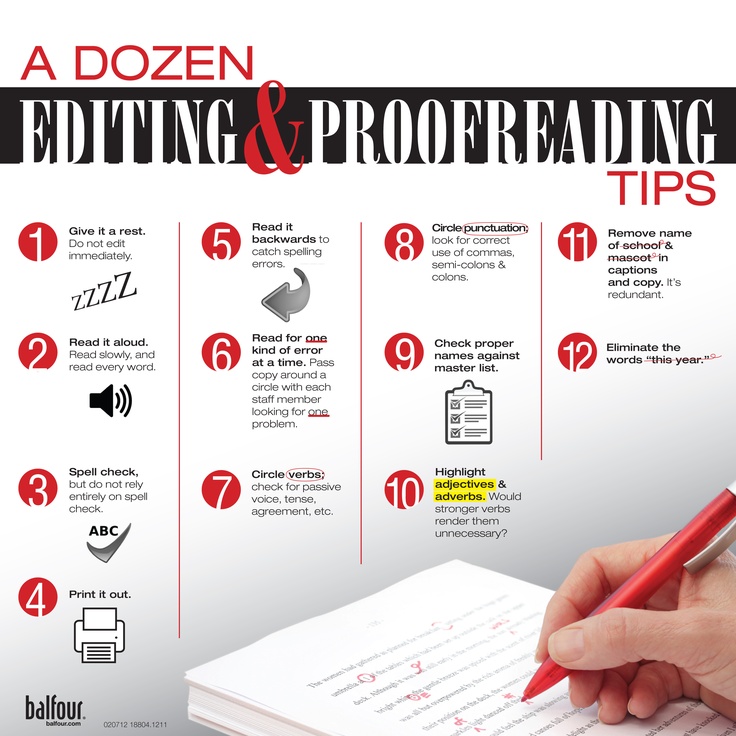 There’s no such thing as a perfect first draft, but it is common for small mistakes to slip through editing and end up in a final draft. Partly this is because when we read our own writing our minds fill in mistakes with what we think is there. That’s why it is recommended to useprofessional English editing servicesto ensure your paper is not rejected simply on the basis of language and grammar. An academic writer should acquire a valuable set of skills to edit their research papers.
There’s no such thing as a perfect first draft, but it is common for small mistakes to slip through editing and end up in a final draft. Partly this is because when we read our own writing our minds fill in mistakes with what we think is there. That’s why it is recommended to useprofessional English editing servicesto ensure your paper is not rejected simply on the basis of language and grammar. An academic writer should acquire a valuable set of skills to edit their research papers.
Here are ten tips academic writers should follow to make their proofreading more effective and writing error-free.
1. Get some space
The easiest way to stop your brain from filling in mistakes from memory is to forget what you have written by spending time away from your writing. Leave a few days between finishing and proofreading and you maximise the chances of spotting mistakes.
2. Give yourself lots of time
Proofreading is more tiring than you’d expect, and tired eyes will miss errors. So don’t leave proofreading to the last minute or try to proofread an entire document in one go—you will miss something!
3. Take breaks
For the same reason, breaks are vital. Proofreading is intense and is best done in short bursts to avoid your eyes and brain getting tired and lazy. Take a rest at regular intervals to avoid overlooking errors.
4. Use a hard copy
Hard copies can feel cumbersome, but they are errors that you will miss on a computer screen will leap out on paper. Hard copies are also much easier to compare to publisher guidelines, make notes on, and to skip back through.
5. Make a list of things to look for
Make a list of mistakes that you know you make regularly, publisher usage requirements, and other things you know you need to look out for. This list will be an invaluable guide to help you through the proofreading process and ensure that you are reading with a purpose.
6. Look for one problem at a time
Be structured while proofreading. Don’t simply read the paper hoping to spot mistakes. Instead, use your list to go through the paper multiple times looking actively for a different item each time. Note each one in a different colour. This will ensure that you catch everything.
7. Don’t forget your tables and figures
Figures and tables are sites of many errors, from incorrect numbering to spelling errors, as they are often forgotten in the proofreading process. Don’t forget to examine them closely and make sure that they are correct.
8. Read backwards
This is a way to trick your brain into reading every word and stop it from filling in what it thinks should be on the page. Instead of reading from the top to bottom, read from the end to the beginning. This will break up the flow of your writing and make you proofread, not read.
9. Read aloud
This also helps to force you to notice every word and every punctuation mark. Your brain can’t skip an error if you have to say it out loud. Reading the entire paper aloud also means that you will focus on the flow and rhythm of the sentences as a whole. This will improve the overall feel of your writing.
10. Get someone else to read it
The most effective proofreading method is to get a different pair of eyes on your work. Someone who is versed in your field will do the best job as they will be able to spot subject-specific usage errors as well as generic mistakes. If no colleagues or friends with good grammar skills are available, a professional proofreader can help make a piece perfect.
Learn more
Writing essays are an inevitable part of an academic life. From school to college and for admissions into your favorite college, you would need to ...
Rejection is part of the writing experience because virtually every writer has been rejected at some point or another. Rejection, unfortunately, i ...
Good grades do not come on a silver platter. You have to work hard to attain them. And with many students often facing the challenge of compositio ...
A good history essay constitutes a lot of detailed historical information, which is presented it in an organised and intellectual manner. The most ...
Academic writing aims to teach the student to express an opinion and generate ideas. Some of the works require deep research. For others, critical ...





